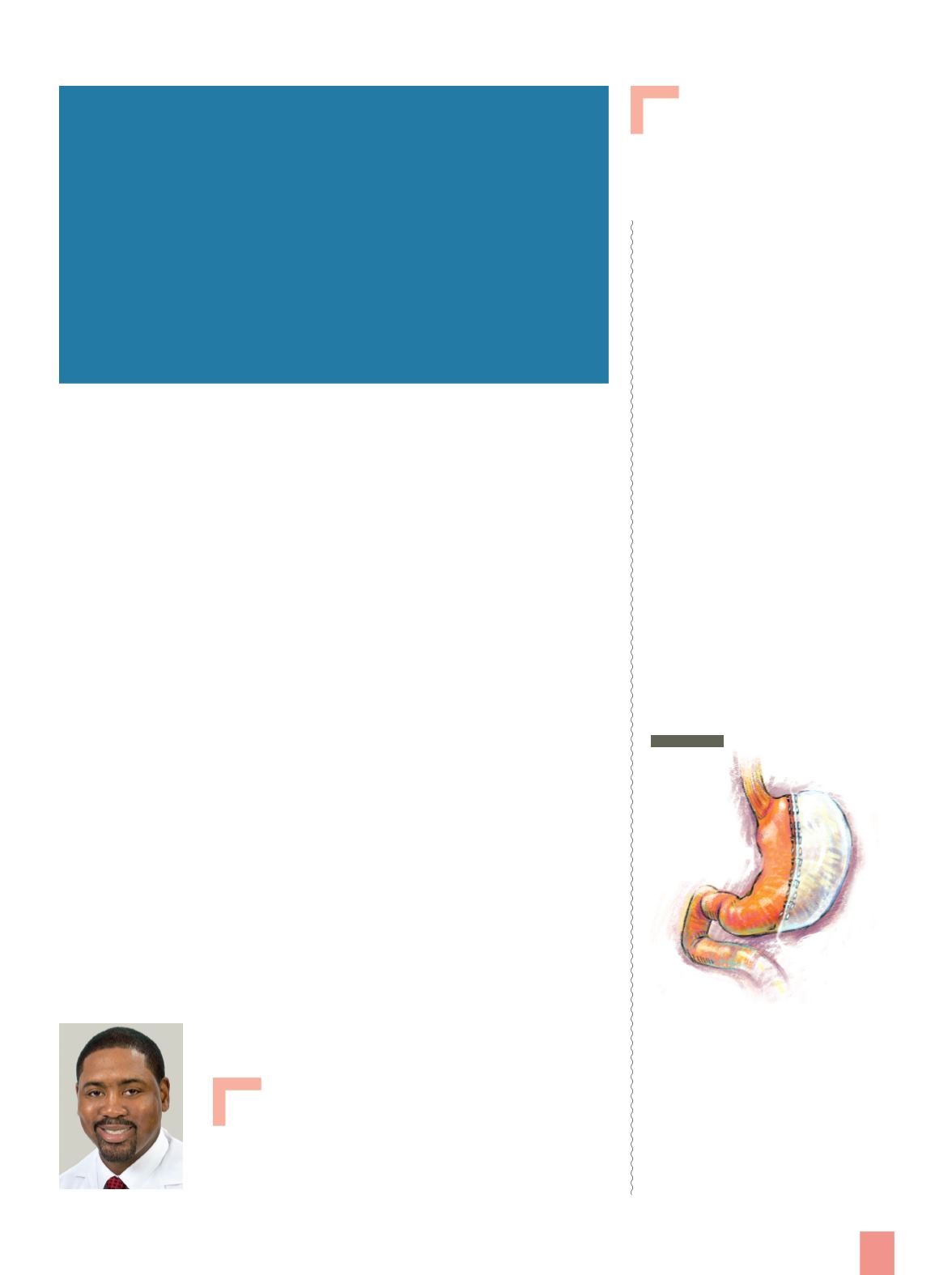

IS GASTRIC SLEEVE
SURGERY FOR YOU?
Gastric sleeve surgery isn’t an
option for all people with obesity.
Ideal candidates meet the following
criteria:
•
Have a BMI greater than 35 and
an obesity-related disease, or
greater than 40 without
•
Are healthy enough to undergo a
major operation
•
Have not succeeded with previous
attempts at medical weight loss
•
Are free of drug and alcohol
problems
•
Have no uncontrolled psychologi-
cal conditions
•
Understand the surgery and its
risks
•
Get approval by consensus from a
multidisciplinary team
The most important factor is that
candidates for surgery must be
dedicated to a permanent lifestyle
change, along with a lifetime of
follow-ups.
Brian C. Gary, MD
uses a band to constrict the stomach, ver-
tical sleeve gastrectomy does not involve
inserting a foreign object into the body.
“The fear I have with the band is, it is
a foreign object, which gives us more of
a possibility for risks and complications,”
Dr. Gary explained.
The average hospital stay after vertical
sleeve gastrectomy is 1 to 2 days. “In
most cases, the stay is 23 hours and you’ll
go home the next day,” Dr. Gary said.
Recovery from vertical sleeve gas-
trectomy will take time and patience.
Because of the drastically reduced size of
the stomach, the diet is very strict.
“It is important that we rethink food,
because the stomach is a muscle and it
can be stretched out,” Dr. Gary said. “The
surgery is set up so you will feel full sooner
and eat fewer calories. You must be dedi-
cated to a complete lifestyle change so we
can set you up for a lifetime of success.”
As the body heals from the surgery,
patients may experience discomfort and
pain. The length of time to return to
normal activities can vary from patient
to patient, but your healthcare team will
advise you on when to return to work
and resume prior activities.
One patient’s story
For Cindy Tucker, one of Dr. Gary’s first
vertical sleeve gastrectomy patients, the
weight-loss surgery has been a resound-
ing success.
In the summer of 2014, Tucker
weighed 372 pounds and decided it
was time to make a life change. With
a BMI of 54, she had vertical sleeve
gastrectomy surgery in September
2014. After four months, she has lost
70 pounds, and the weight continues to
come off.
“I am so happy,” she said. “I have tried
to lose weight in the past, but the plans
did not work for me. I believe, partially,
that was due to the fact that my mind
was not quite ready yet, to be honest.
As I approached 40 years old, I realized
that I needed to change my ways fast.
This surgery is a permanent tool.
“I have changed my lifestyle com-
pletely,” Tucker added. “I now go to the
gym, which I was afraid to do before.
But now, it makes me feel better every
time I go! Even my family is involved in
my weight-loss journey. I would abso-
lutely recommend this to anyone who
is ready for a lifestyle change.”
WEIGHING IN: THE BENEFITS OF WEIGHT LOSS
Vertical sleeve gastrectomy has a
mean excess weight loss at 3 years
of 66 percent. In addition to weight
loss, the surgery also helps to re-
solve obesity-related health condi-
tions. These include:
• Obstructive sleep apnea: 45 per-
cent to 76 percent resolved
• Asthma: 39 percent improved
• Urinary stress incontinence:
50 percent resolved
• Osteoarthritis and other degen-
erative joint disease: 41 percent
resolved
• Depression: 47 percent reduced
• Migraines: 46 percent improved
• Type 2 diabetes: 45 percent to
68 percent resolved
• High blood pressure: 42 percent
to 66 percent resolved
• Nonalcoholic fatty liver disease:
37 percent resolution of steatosis
5
Considering bariatric surgery? Attend our next weight-loss seminar with Brian Gary, MD, on March 24. Visit Jackson.org/events to find out more. What’s your BMI? Find out at Jackson.org/ BMICalculator.Vertical sleeve gastrectomy is a
laparoscopic procedure in which two-
thirds to three-fourths of the stomach
is removed, leaving the remaining
portion of the muscle. The stomach
can typically hold 1.5 to 2 liters of
fluid or food, but after the surgery,
the stomach is roughly the size of
a banana and can only hold about
150 milliliters.

















